2.12 Making Sauternes & Sticky Wines
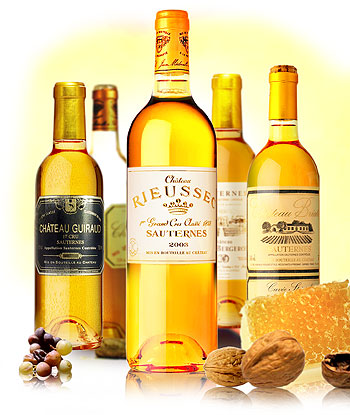
The greatest examples of sweet winemaking possess amazing concentration combined with perfect balance, precision acidity and freshness, whilst at the same time being exceptionally long lived. They are some of the most exciting and expensive wines in the world(a bottle of 1787 Chateau d'Yquem was purchased for the record breaking sum of 90,000 US dollars, to date, the most expensive white wine ever sold).
Where fortified wine involves adding spirit to halt the fermentation artificially, the most common cause of fermentation cessation in the production of sweet wines is the extraordinary sugar levels of the fermenting grapes. This naturally drives the alcohol level above 15% Alc./Vol. to a point where the yeasts can no longer exist, leaving behind varying degrees of residual sugar. The high sugar concentration in such wines is primarily the result of grape dehydration, which increases the ratio of sugar to water, and can be achieved in a variety of ways:
1. Late Harvest, with or without cane-pruning to assist desiccation, by making use of the hot climate in the warmer grape growing areas. Such wines often require acid addition to obtain the desired balance of sweetness to acidity.
2. Drying Grapes after harvest, a traditional Italian/Spanish technique in which grape bunches are spread out on mats under the sun.
3. An extreme late harvest where the grapes are left on the vine into the dead of winter. On a suitably freezing cold night the grapes are harvested to create Eiswein (ice wine). Most of the water content of the grapes has turned to ice and this is expelled from the grapes leaving only the sugars and acids behind.
Of particular interest in this section, is a fourth technique, though one could argue it is not so much a technique as a freak of nature. Whatever the case, time and experiment have made clear only very special terroirs can consistently produce exceptional wines from the harvest of Botrytis effected grapes. To understand why this is so, is to understand the capriciousness of the Botrytis mould. As one commentator described it, Botrytis is"...unique amongst grape parasites in that, depending upon the conditions of infection, the grapes may be used to produce some of the world's most sought after dessert wine, or be sold as distilling material".(1)
Its origins as a wine style almost certainly came about by accident.
The Origins of Botrytis Effected Wines
Tradition which knows everything, has several versions of the origins of Botrytis effected wine. The Hungarian priest and vintner of Zssuzsanna Lorentfly's estates, Me¡te Szepsi Laczke, discovered it because an impending invasion by the Turks in 1650 delayed harvest, resulting in 'disaster' in the vineyard. Within the next century the great sweet wines of Tokaji had a place in both French and Russian courts. The Teutonic legend has it that in 1775, as the grapes ripened on the vines, a messenger conveying permission to begin harvest failed to reach an estate. The grapes were soon riddled with Botrytis and so the German Auslese, Beerenauslese and Trockenbeerenauslese wine styles developed.
In France, the professional bodies of Sauternes, Syndicat Viticole de Barsac and the Syndicat Viticole de l'A.O.C Sauternes, maintain that a strong semi sweet white wine was produced as early as the 18th Century: One year, a spring and a summer were very hot and followed by a series of rains which obliged the wine makers to postpone harvest, instead reverting to a method of successive pickings - that is, only picking the ripe grapes and then returning to pick more grapes as they ripened. At some point, they discovered much of the fruit had 'rot', but decided to ferment the grapes anyway.
The Life Cycle of Botrytis Cinera (latin for 'Ashy Cluster' descriptive of what infected grapes look like on the vine; syn: grey rot.)
The 'discovery' of this ambiguous growth is not so surprising when we learn that Botrytis cinera fungus is a very common pathogen in nature, and causes diseases on all kinds of damp plant material. Even though most growers spray to avoid its effects, it remains a serious problem in any vineyard endeavoring to produce dry table wines. Viticulturalists refer to it as a primary pathogen because it can attack undamaged fruit, greatly reducing vine yield and wine quality. Berries of all vine varieties are susceptible. In Australia it occurs mainly in cool climate regions subject to high humidity, though it has also found favour with the Riverina region of New South Wales.
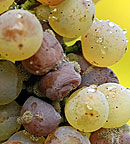 |
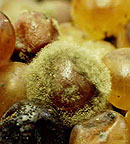 |
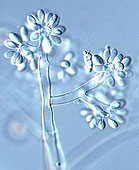 |
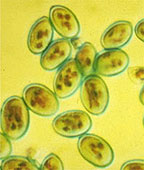 |
|
| Botrytis effected Riesling. | Close up of the mould. | Botrytis magnified x500 * | Botrytis Spores. |
Large numbers of rounded conidia are budded off at the branched ends of the long (to 2 mm), stiffly upright conidiophores.
During the winter the fungus exists in a dormant form in mummified berries, dead grape tissues and other organic debris in and around the vineyard, as well as on a multitude of alternate plant hosts. Because of its wide host range, growers can assume that Botrytis is present in the vineyard throughout the entire year. Thankfully, the mould remains dormant unless specific weather conditions prevail. For Botrytis spores to germinate, the humidity must be around 90% for about 24 hours. Characteristic of Botrytis is the production of sclerotia, which are large, dark-coloured resting structures consisting of compacted hyphae (fungal body) that can be seen with the naked eye as dark brown to black dots. These are wintering or "resting" structures that allow the fungus to withstand adverse environmental conditions. During high humidity, the fungus germinates from the sclerotia and then produces conidiophores, tree-like extensions bearing conidia, or spores. Mature conidia detach and are carried on the air, latching onto hosts. In many cases the conidia enter a host through already damaged or susceptible tissue; via a wound is common, although tip-scorched or withering leaves are susceptible, as are fragile seedlings. For the Botrytis to continue to grow, the humidity must then drop below 60% together with temperatures in the range of 20-25ºC. On the host the spore generates fresh mycelia which "...penetrate berries either directly or through microscopic cracks and other lesions. Subsequent growth brings about further rupture of the epidermal tissues, thereby making the fruit susceptible to growth of secondary pathogens such as Aspergillus, Mucor, Rhizopus and Penicillium". (2) These common bunch rots are called secondary pathogens because they can grow only where a crack already exists in a grape such as those caused by birds, insects, hail, powdery mildew or excessive rain which can cause grape splitting due to sudden water uptake. Such organisms emit unpleasant odours: Aspergillis growth, for example, gives off a "smelly sock" odour while Penicillium smells rotten making the grapes unsuitable for winemaking.
With further growth the Botrytis mould goes on to produce the tree-like conidiophores again, water is absorbed causing the intracellular pressure to increase and eventually rupture, thereby releasing spores into the air. "Depending on conditions after infection, the cycle from germination to the production of spores may take less than 3 days...Where conditions within and surrounding the cluster remain wet and the relative humidity high (>90%), berry dehydration does not occur. Thus the concentration of grape sugars either remains the same or decreases. In this scenario, growth of botrytis and secondary moulds, native yeast and bacteria rapidly ensues, resulting in bunch rot." (3)The fungus and secondary pathogens crack and loosen the grape skin such that when the berry is gently squeezed, the skin seperates easily from the pulp. The occurrence of severe outbreaks of bunch rot is closely correlated with high relative humidity and the incidence of rainfall during the pre-harvest period, both of which prevent any dehydration of the berries which would attenuate botrytis growth.
The botrytis growth cycle ends when cold weather forces the organism into hibernation once again.
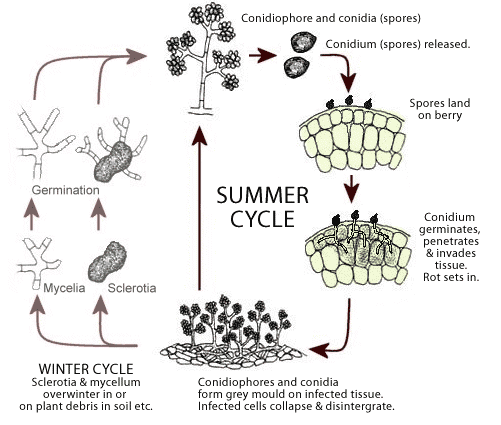 However, the disease does not always follow the same course.
However, the disease does not always follow the same course.
In Sauternes production, everything depends upon the weather and"Where warm sunny and windy weather follows the primary infection by Botrytis, free water in the cluster evaporates and the fruit begins a process of dehydration. Although mould and bacterial growth continues to consume a portion of the grapes sugars and acids, this is countered by dehydration, such as that there is net increase in both..." (4)
When this remarkable sequence comes about, what was once lowly bunch rot is suddenly elevated to the status of "noble rot." (The French refer to this as 'pourriture noble', whilst the Germans called it 'Edelfaule'). It transforms the plump, healthy grape into the raw material for the honeyed and nectar-like dessert wines of new world producers in California, Australia & New Zealand, the exotic and rich Trockenbeerenauslese and Beerenauslese of Germany and the decadently sweet Sauternes wines of France.
Case Study:
Sauternes, France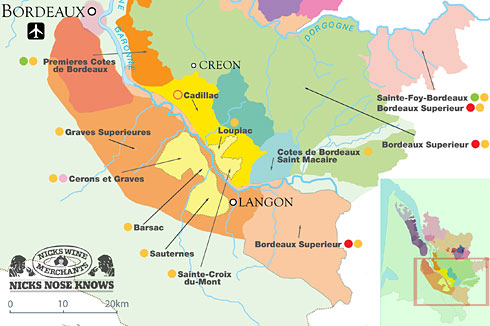
Most people would agree that the most sought-after and certainly the most expensive dessert wines produced from noble rot come from the small Appellation in Bordeaux, now world famous, known as 'Sauternes'. There are five small communes that are entitled to the Sauternes appellation. These villages are Sauternes, Fargues de Langon, Bommes, Preignac and Barsac. Chalk and clay soils are found in Bommes, Sauternes and Preignac, whilst grit and sandy soils are found in Fargues de Langor and Sauternes. Vineyard orientation is very important, and the great vineyards all have a north east aspect which ensures that grapes are fully ripened, as compared with over-exposure on southerly aspects. The properties throughout the region are relatively small. There are 19 large vineyards over 20 hectares (50 acres), 83 vineyards between 5 and 20 hectares (12-50 acres) and 159 under 5 hectares (12 acres). The total area of Sauternes is restricted to around 1900 hectares (4700 acres) and is planted with three varietals. Approximately 70% Semillon, 25% Sauvignon Blanc and 25% Muscadelle, although it must be said that the cepage does vary from vineyard to vineyard. These varieties are susceptible to botrytis rot for two reasons: Either they have thin skins which are more easily pierced by the fungus, or the grapes grow tightly packed together in the clusters causing poor air circulation between berries creating a micro-climate conducive to fungal growth.
Noble rot does not eventuate every vintage in Sauternes, emphasizing the exceptional and fortuitous circumstances required to produce its sweet wines. When it occurs, this is how it happens:
The Garonne River forms the back bone of Bordeaux and so also, Sauternes. It is wide, deep and slow, and as a result relatively warm. A small trout stream called the Ciron, whose origins are in the Lendes region, runs quickly and is relatively cold. This stream, where it hits the Garonne creates a new microclimate of humid mist during autumn mornings and under such warm, moist conditions, infected berries readily become covered with grey botrytis growth, especially as the grapes proceed to full maturity when the berries are large and often tightly packed; this allows for progression of the Botrytis across the bunch, possibly from just a single spore landing on one of the grapes. In addition, ripe fruit is sugar-rich, providing a food source for the fungus. At this stage, the spores are growing both onto and penetrating beneath the skins of the grapes.
 |
 |
 |
 |
 |
 |
 |
|
| 1.Ripe Berry 60 hl / ha 13 ° |
2. Contamination by Botrytis Cinerea |
3. Development of brown marks |
4. A purplish colour appears |
5. Berry wrinkles and a white down appears : this is the full rotten level |
6. Rotten candy levels 12 hl / ha. 21 ° 355 g/l sugar |
7. Intense concentration |
Infected berries first appear soft and watery. The once healthy berries then begrivel up and take on the appearance of dried-out mouldy raisins. The berries of white cultivars becle wn, and those of purple cudevelop a reddish colour.
As the spores envelop each grape, extraordinary chemical and physical changes are occurring in the berry which differentiate noble rot from other sweet winemaking processes. These changes impact on the behavior of the fermentation and on the organoleptic qualities of the finished wine and can be either desirable(+); undesirable or problematic( - ): both, depending on circumstances(+/-); or questionable(?):
Under ideal conditions, botrytis conidiophores which penetrate the skin initiate a dehydration of the berry, and the sugars are concentrated. In fully infected berries which are completely mummified by Botrytis, sugar concentration can easily be doubled.
2) Decrease in Tartaric and Malic Acids; Increase In pH (+)
As water is lost from the berry, its constituent acids are concentrated. However, at the same time the Botrytis fungus is metabolizing these organic acids for use as an energy source. This results in an increase in pH and a decrease in acid concentration. The juice and wine thus taste sweeter and softer.
3) Production of Glycerol (+) and Polysaccharides (-)
Glycerol is excreted by the Botrytis fungus, and as a result the glycerol concentration of the wine can be up to four times higher than normal--as high as 30 g/L. Glycerol makes a slight contribution to increased mouthfeel and possibly sweetness, although its effect is often overrated. In addition to glycerol, glucans can be formed in the juice, and their presence makes clarification and filtratioifficult. These long-chain polysaccharides tend to be expressed from the grapes during heavy pressing.
4) Oxidation of Polyphenols (+/-)
The enzyme produced by Botrytis, laccase, is secreted through the hyphae into the berry. It is completely soluble, and thus finds its way readily into the juice. Laccase activity causes the juice to change in colour to a deep gold. It also causes a modification of those phenolic compounds causing bitterness and astringency, making their impact less pronounced. On the 'down' side, laccase is much more resistant to deactivation than polyphenol oxidase. Its effect diminishes more slowly over time, and it can tolerate significantly higher levels of SO2.
5) Oxidation of Sugars (+/-)
The oxidation of glucose and fructose in the grape berry gives rise to a range of honey/caramel flavours which contribute positively to wine quality as well as to colour. However, oxidized sugars bind readily to bisulfite, and their presence in the juice and wine makes attaining adequate free S02 very difficult without attendant high total S02 (often 250-300 mg/L).
6) Oxidation of Monoterpenes (?)
In varieties with high concentrations of volatile monoterpenes, such as Riesling, oxidation of these compounds by Botrytis fungi will result in a loss of varietal character intensity. In practice this does not seem to be a problem, since sufficient varietal character is usually retained in successful examples of these wines.
7) Exhaustion of Nutrients (-)
Botrytis juices are usually deficient in essential nutrients (ammonia, free amino acids, thiomin), and unless additions are made to the juice, fermentation is likely to be sluggish and excessive amounts of H2S will be produced.
8) Production of Botryticine (?)
Botryticine is an antibiotic produced by Botrytis that is inhibitory to yeast growth. It is not clear whether botryticine has any significant inhibitory effect on wine yeast during fermentation. Its presence seems to prevent subsequent yeast growth in finished wines, as Botrytis wines do not re-ferment as easily as wines from uninfected grapes. (5)
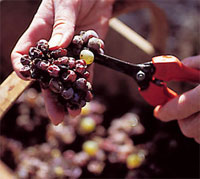
The yields from Sauternes are understandably minuscule. Berries may lose up to 50% of their original weight, mostly due to the Botrytis mould removing moisture from the pulp. Under the Appellation Controllée laws, a yield of 25 hectolitres per hectare is permitted; in reality, however, the average production ranges from 15 to 20 hectolitres per hectare, and even that can be reduced by as much as 20% by the time the wine under goes barrel maturation and is bottled. It has been said that a vine from Sauternes produces on average between 2 or 3 glasses per year, whereas vines producing a different kind of wine might be expected to yield 5 - 10 times that amount.
There is a fine line between noble rot and bunch rot, and the pre-harvest period becomes an anxious affair for the viticulturalist. The continued alternation between damp misty mornings and drier, warm afternoons is essential to preventing a rampant progression to bunch rot. Even given nature's benevolence, a technical challenge remains to retain sufficient acidity in the fruit in order to avoid the wine from becoming cloying on the back palate. That is, it is undesirable for a 'sticky' to be so sticky (sweet) that it 'sticks'. Because botrytis does not encase bunches all at once nor are all berries or bunches affected to the same extent by its growth, acid and sugar levels are not uniform across the vineyard. This dilemma necessitates harvesting the fruit in several waves (called 'tries' in French.)
Taking care to avoid bees or wasps, which can make harvesting hazardous, experienced pickers select only bunches or even individual grapes that are considered perfectly affected. (At Ch. de Fargues, for example, the aim is to harvest fruit with 20opotential natural alcohol. In other words, the juice coming out of the press must contain 340-350 grams of sugar / litre). Consequently, harvesting is laborious and can prolong the vintage for 4-8 weeks, with up to 13 selective pickings during a vintage not uncommon. This rigorous selection of only optimum fruit is one of the secrets behind great Sauternes.
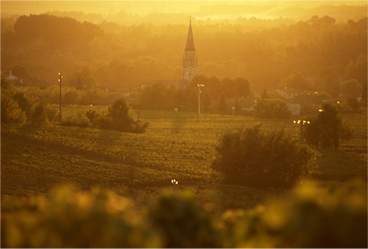 |
| The Sauternes & Barsac 1855 Classification In 1855, the Chamber of Commerce of Bordeaux required to list and to classify the great wines from Medoc and Sauternes. Below is the classification, which was carried out for the wines of Sauternes and Barsac. (It should be noted that this classification has not been re-examined since 1855). Nicks Wine Merchants continue to import and stock a wide range of Sauternes and Sauternes style wines. Click the links below for details. Premier Cru Superieur * Chateau d'Yquem Premiers Crus * Chateau Climens * Chateau Coutet * Chateau Guiraud * Clos Haut-Peyraguey * Chateau Lafaurie-Peyraguey * Chateau Rabaud-Promis * Chateau de Rayne-Vigneau * Chateau Rieussec * Chateau Sigalas-Rabaud * Chateau Suduiraut * Chateau La Tour-Blanche Deuxièmes Crus * Chateau d'Arche * Chateau Broustet * Chateau Caillou * Chateau Doisy-Daëne * Chateau Doisy-Dubroca * Chateau Doisy-Vedrines * Chateau Filhot * Chateau Lamothe * Chateau Lamothe-Guignard * Chateau de Malle * Chateau de Myrat * Chateau Nairac * Chateau Romer du Hayot * Chateau Suau Some other wines that are made in France that are often botrytis-affected wines include: * Monbazillac (Bergerac; Semillon) * Cadillac (Bordeaux; Semillon, Sauvignon Blanc) * Sainte-Croix-du-Mont (Bordeaux, Semillon, Sauvignon Blanc) * Coteaux du Layon (Anjou - Loire; Chenin Blanc) * Bonnezeaux (Anjou - Loire; Chenin Blanc) * Quarts de Chaume (Anjou - Loire; Chenin Blanc) * Vouvray (Sweet) (Loire; Chenin Blanc) |
Winemaking
As soon as the grapes are picked they are transported to the winery in small plastic crates. Grapes devoid of juice are difficult to press, and the winemaker may need to persevere with several pressings in order to produce a respectable volume of wine. At the Premier Cru Sauternes house, Ch. Guiruad, four small pneumatic presses are employed which help to separate different batches. Initially, low pressure is used to release the first, less intensely flavoured juice. After about one hour, the pressure is slowly increased. The must extracted at this stage, taking approx 2 hours, will be richer than in the first pressing. During the last hour, to extract the best juice the pressure is at its maximum. This process may be repeated as many as 50-60 times as new waves of fruit are picked, until the end of harvest. Once extracted, the must flows down from the press bottom to 25hl thermo-regulated stainless steel tanks (located underground). The wine is cooled overnight to 5-6° during which time any suspended particles in the juice drop to the bottom of the tank. The juice is transferred to new oak barrels, via an air pressure system placed inside the tank, compressing the juice and forcing it out.
Each lot is fermented separately and carefully monitored. Once started, fermentations may become stuck as high sugar musts are a difficult environment for the yeast to grow in. Much may be done in order to encourage fermentation, including warming the fermenting must. Due to the extremely high sugar levels, fermentation is slow, sometimes taking several months to reach the correct balance of alcohol and sugar, compared to a week for table wine fermentation.
It has also been conjectured that Botrytis cinerea itself slows fermentation. As already mentioned, the organism yields botryticine, an antimicrobial substance which is thought to inhibit the action of yeasts during fermentation and also inhibit secondary fermentation in the bottle. Ideally, fermentation stops naturally when a balance of 13.5 - Alcohol and approximately 100-120 grammes of residual sugar is reached. At this point the yeast is asphyxiated and inhibited by the alcohol produced during fermentation. Some estates still find sulphur necessary, both to stop successful fermentation and to try and protect against re-fermentation of the high residual sugar in bottle (usually between 5-15%).
Before being bottled, Sauternes is allowed to age in oak casks for two to three years , at which time the wines are usually within the range of 12-14% Alc./Vol. The finished wines are so thick that they are difficult to pump and often clog conventional filters.
Serving Sauternes
The effect of botrytis is not only to create a new range of flavours in the wine, with the presence of apricot aromas and flavours in particular, but it also contributes other characteristics including additional glycerin. (In normal wine there is about 1% of glycerin present; however, in botrytis affected wines, by contrast, this level can reach 3%, giving the finished wine a luscious, satiny mouth feel). There are many other common aromas and flavours of Botrytis effected wines which make for some extraordinary wine and food matches. Always remember, when serving Sauternes, it should be only slightly chilled - just taking the edge off it is enough. As a rule of thumb place the wine in the refrigerator just as main course is being served.
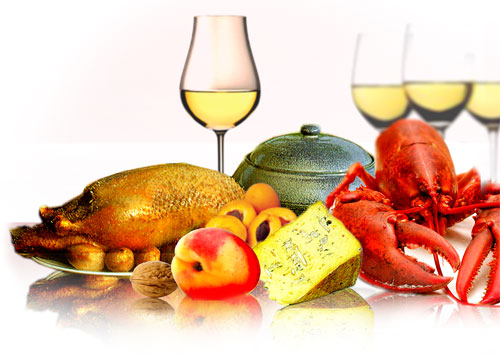 |
| Sauternes is a match for a surprising range of dishes. |
For those uninitiated in Sauternes, let it be said that the versatility of these wines cannot be underestimated. An entire three course meal can easily be created around Sauternes wines alone, with the results being some of the most exciting wine and food matching sensations one is likely to experience. Apart from classic dessert combinations like cream caramel, fruit pies, fruit salads, soft fruits or freshly cracked walnuts, there are more adventurous alternatives. Many of these you wouldn't think of unless you visited the region itself and spent some time with the locals. On one trip to Sauternes, I dined at the Auberge du Vn Sauternes, where the only food being served was duck, barbequed on the dry canes of Sauternes vines anrved with a plate of fs (McDonalds-type thin slices of fried potato). The wine was 1983 Chateau Guiraud Sauternes. The combination - sensational. On another occasion, again in Bordeaux, but this time at the pickers lunch at Chateau Petrus, rough barbeque lamb chops which had been marinated in Sauternes were produced for the hungry pickers; again the combination was wonderful.
Other combinations which may come as a surprise include Roquefort cheese, ewes milk cheese, a quiche or black pudding and apples(boudin aiy pomsies), pan fried trout and needless to say, the traditional combination of Sauternes and foie gras. However, perhaps the most surprising match, and a favourite of Comte Lur Saluces, owner of Chateau d'Yquem, is Crayfish and Sauternes. The combination is nothing short of sublime, and when one considers the price and quality of some Sauterne style wines in great years, like the Chateau Fayau Cadillac, it is an indulgence that should not be out of the question!
And then there is the classic dish of Sauternes and duck.
But need we tempt you further?
1. Wine Microbiology, By Kenneth C. Fugelsang Published 1997 Springer
2. Ibid
3. Ibid
4. Ibid
5. Sweet Wines. Peter Bell, Cornell University with information referenced to Croser, B. "Botrytis Affected Wines". Aust. and NZ Wine Industry Journal, 4:3, 155-158.
Some technical info sourced from "Fascinating fungi and the noble rot". Wines & Vines, Oct, 1994 by Jordan P. Ross and from Chris Kissack, www.winedoctor.com
* Magnified photograph of Botrytis by A.J. Silverside, sourced from http://www-biol.paisley.ac.uk/bioref/Fungi/Botrytis_cinerea.html
